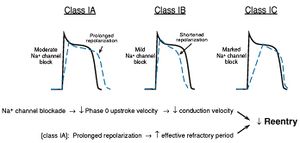We need you! Join our contributor community and become a WikEM editor through our open and transparent promotion process.
Procainamide
From WikEM
Contents
General
- Type: Class Ia Antiarrhythmic
- Dosage Forms: 100mg/mL (10 mL); 500mg/mL (2 mL)
- Common Trade Names: Apo-Procainamide; Procainamide Hydrochloride Injection
Adult Dosing
Arrythmia
- Considered Drug of Choice for stable Wide-Complex Tachycardia Class IIa reccomendation
- 17 mg/kg at a rate of 20 - 50 mg/min; intravenously over 25 - 30 minutes
- Give until:
- arrhythmia is suppressed
- patient develops hypotension
- QRS segment prolongs by >50% of baseline
- total of 17 mg/kg is given; max 1 gram
- If effective, start continuous infusion at 1-4 mg/min
- Continuous infusion has fewer adverse effects than bolus
Pediatric Dosing
Arrythmia
- Stable wide-complex tachycardia or SVT
- 15mg/kg infused over 30-60 minutes
- Stop infusion if hypotension occurs or QRS complex widens by >50% of baseline
Special Populations
- Pregnancy Rating: Class C
- Lactation risk: Procainamide and its metabolite are found in breast milk. Due to the potential for adverse events in the nursing infant, breast-feeding is not recommended by the manufacturer.
- Renal Dosing
- Adult
- Pediatric
- Hepatic Dosing
- Adult
- Pediatric
Indications
- Wide-complex tachycardia of unknown type (in patient with preserved left ventricular function)
- Stable ventricular tachycardia
Contraindications
- Allergy to class/drug
- Not recommended for ventricular fibrillation or pulseless ventricular tachycardia, as it takes too long to dose
- 2nd or 3rd atrioventricular block
- Severe glycoside intoxication
- Prolonged QT segment
- Myasthenia gravis
Adverse Reactions
- Myocardial depression
- Watch for QRS/QT segment prolongation, ventricular tachycardia, ventricular fibrillation, complete atrioventricular block, torsades de pointes
Pharmacology
- Half-life:
- Children: 1.7 hours
- Adults with normal renal function: 2.5-4.7 hours
- Metabolism: By acetylation in the liver to produce N-acetyl procainamide (NAPA)
- Excretion: Urinary excretion (25% as NAPA)
- Kinetics: Onset of action 5 - 10 minutes
Mechanism of Action
- Class Ia
- Binds to fast sodium channels in inactive state inhibiting recovery after repolarization
- Prolongs action potential and reduces speed of impulse conduction
- Depresses myocardial conduction
- May act as negative inotrope, causing hypotension through peripheral vasodilation

